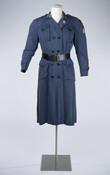Uniform
Description
Woman's WWII Red Cross Motor Service uniform that includes a blue dress (a) with folded collar and notched lapels with a double breasted front that closes with eight black buttons. The dress has pockets with buttoning flaps on both sides of chest and hips and a proper left sleeve that bears an embroidered patch reading "American Red Cross Motor Service." Underneath the patch is an oval badge embroidered with a red cross and the words "Emergency First Aid and American Red Cross." The lower sleeve has a patch of 5 red bars, and both long sleeves button at the cuffs. A lapel pin (b) features a red cross and the words "World War II/ ARC" engraved along the bottom edge. The dress is cinched at the waist with a wide black leather belt (c). The American Red Cross Motor Service Corps was developed in World War I, during which over ten thousand women volunteered to deliver supplies and transport the sick and wounded. The Motor Corps continued to serve during the Second World War, this time with over 45,000 women like Virginia Newcomer, who completed rigorous training to volunteer as a transport and supply driver. While women’s uniforms carried some menswear characteristics like a double-breasted closure, patch pockets, and leather belt, their skirts made them distinctively feminine. The fabric of this Motor Corps dress from 1942 may look like wool gabardine, but it is actually a grey-blue spun rayon, a much lighter fabric used in dressmaking. To complete her uniform, Newcomer would have been required to wear a low-heeled black shoe and silk or cotton hose at all times.
Creator
Date
circa 1944










